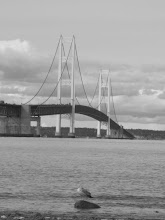History is always a good place. When Michigan was originally explored by the French back in the mid-1600s, the essentially began in the north and went south. In 1668 Father Marquette founded Sault Ste. Marie—making the city the third oldest settlement east of the Appalachian Mountains. Fur trading back to Europe helped bring this area to life during the 1700s and into the late 1800s. During the end of fur trading, lumbering began to take over. While a profitable industry, the lumber barons destroyed thousands of acres of forest. By the early 1910s and 1920s the Eastern UP was suffering because of the decline in lumber profitability. Long before the Great Depression swept the nation, businessmen and citizens of the Eastern UP began to suffer. A little known fact is that President Hoover began a Civilian conservation Corps type program years before Roosevelt. However, President Roosevelt took Hoover’s small relief programs and expanded them to a level unseen in history. Enter President Roosevelt in 1932. A few months after his election, he began the Civilian Conservation Corps. The workers of the CCC restored THOUSANDS of acres of land, created hundreds of miles of roads and paths, and created the camping areas in many of the national and state forests. Thanks to the CCC replenishing the forests in the 1930s, we can enjoy them now. Hiawatha National Forest is the largest forest area in the Eastern UP and offers several places to camp (which are usually cheaper than the state camp grounds and you don’t need a park pass to enter, just a little FYI).
Also the northern end of the Mackinac Bridge ends in St. Ignace, but I will save an entire entry for the bridge later…
Munising is a great spot to visit if you love maritime history, like myself. You can take kayaking tours of the river and bay area and see wonderful wildlife and shipwrecks. Most of the schooners are shallow wrecks that you can basically see from the surface of the water. That being said, this is also a prime area for scuba diving.
My favorite place in the entire state is Whitefish Point. It is my home. There is nothing like sitting on the shore of Lake Superior and wondering what it must have looked like when Douglass Houghton walked those very shores. Whitefish Point is an active lighthouse and Coast Guard Station as well. The most notable artifact in the museum is the bell taken from the wreck site of the Edmund Fitzgerald (again, another entry for that will come later.) One thing I have always wanted to do is rent one of the guest quarters at Whitefish Point. It’s rather expensive but seems like a great experience.
From Whitefish Point you can head south and hit Tahquamenon Falls. There are the Upper and Lower falls, and both are amazing. Also, the park offers modern camping AND a brewery! That’s right a brewery! I recommend the Blueberry Ale. Delicious!



Sault Ste. Marie is also a nice little town. Over on Water Street there is a row of historic houses being restored. One house was lived in by Henry Rowe Schoolcraft, who did early surveying of Michigan, and John Johnston. My favorite museum though is the Valley Camp, which is a retired Great Lakes Freighter that you walk through. They have wonderful exhibits and some great Fitzgerald artifacts. The Soo Locks are an interesting visit as well; there is a wonderful park, visitor center, and viewing areas to check out the freighters that pass through. Also West Pier and Clyde’s have GREAT burgers...just a little tip from the locals.


St. Ignace is the first city you go through in the Eastern UP, and has a couple of cool spots. Firstly, there is the Father Marquette Memorial and the Straights Park, both of which offer wonderful views of the Mackinac Bridge. But you NEED to go to Lehto’s Pasty Shop, which serve some of the best pasties in St. Ignace. If you want some great whitefish, you must go to the Driftwood on State Street. It’s the some of the best whitefish I’ve ever ate.
As a side note for future Bridge Walkers, I recommend staying in St. Ignace. It seemed much easier to start in St. Ignace than Mackinac City. Plus there are plenty of places to stay. In fact, I booked a camp site at Carp River like a month before the walk, and even when we got there spots were still available.
There’s just a few places I like to go to in the Eastern UP. I’m sure I can mention many more, but I hope this encourages you to do a little exploring yourself if you make it up there.




